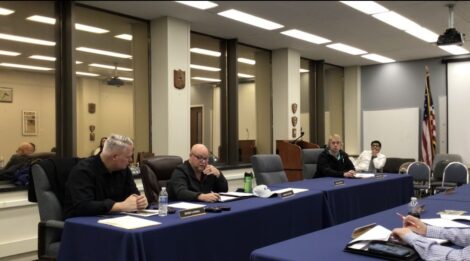Barometer Indicates Pressure On Fewer Taxpayers
Editor's Corner

Once the summer celebrations come to an end, municipalities will start to focus on spending plans that will keep increasing. Photo by Sandra Shisler
Diverse Chautauqua County appears to be in a bit of a conundrum during a summer season that continues to impress. As festivals and events fill the calendar across the region, there is no denying the enthusiasm and community spirit.
Within the last seven days, highly attended events have included:
— A First Friday celebration — delayed due to the July 4 holiday — took place in the village of Westfield bringing crowds to businesses and vendors along Main Street.
— The Chautauqua County Fair is in full swing through Sunday in Dunkirk with entertainment, rides and its annual displays that include participation from the agricultural community.
— Chautauqua Institution, an international gem, is in its fourth week with its theme being “The Future of the American Experiment.” Week Five, which begins this weekend, features “Innovation in Capitalism.”
There also is a cornucopia of happenings this weekend taking place as well. Included are the Scandinavian Festival in Jamestown, a Beach Bash in Dunkirk and the Chautauqua County Historical Society Antique Show in Mayville to name a few.
All of these items, of course, provide the high points. But there is no denying the struggle facing some government entities that still may pass on higher taxes and fee increases to constituents for next year as 2025 surpasses the halfway mark.
Residents of the 27 county townships have dealt with the least upheaval. Leaders consistently approve conservative spending plans while not having to deal with the high-priced employees that come with police and fire departments.
That is the good news. But here is where things get shaky.
Those residing in 10 of the 13 villages appear to be in a favorable routine. Three are facing turbulence.
In Fredonia, recent water problems — again — and an approved 56% tax increase have brought a nasty mood in recent weeks, as noted by its fire chief during a bottled and can water distribution drive earlier this week
“Regrettably, while providing assistance, our personnel have faced unacceptable behavior, including rude comments and argumentative conduct from community members coming through the line,” Josh Myers wrote in a Facebook post Monday. “Our personnel are dedicated to serving the community, and it is essential that they are treated with respect and dignity. You have a right to feel however you’d like about this water situation, but the men and women of the Fredonia Fire Department are simply stepping up to help during this time of difficulty. We are not the enemy.”
It is much calmer in Lakewood, despite its 22% tax increase. In Cassadaga, board members are dealing — and ignoring at the same time — a black eye of a Department of Public Works director being charged with vandalizing one of its businesses and taxpayers.
Our two cities face the most volatility. Across upstate in recent decades these entities have tried to find a balance between their glory days and the impending ruin facing their future.
For Dunkirk, it finally had to pay for its overspending by passing on the 84% tax increase to residents. Last month, it received a $13.6 million loan from New York state to pay off a Revenue Anticipation Note due this month. It came with a 7.5% interest rate. That’s no reason to breathe easier.
South county Jamestown has been on the cusp of a crisis for years. Its situation is only different from their counterpart in the north county in that it has a much better grip on its financial data. That helps in forecasting for the coming years, but does little to stop the continued bloated spending plans that shackle the once vibrant municipalities.
Finally, that brings us to the lackluster and underperforming government that is Chautauqua County. Through six months of this year, this Republican-led body has shown no remorse in continuing to overtax those they serve while clinging stingily to its $38 million in reserves. Legislators refused to lower the sales tax in March that stands at 8% and it raised property taxes this year despite its trickery noting a lower rate.
In addition, this $302 million operation continues to add employees to the payroll since 2016 — up 6.5% — while deceptively touting itself as being financially responsible. On the flip side, the population has decreased by 5,200 to 124,100 residents during the last eight years.
Why is government growth acceptable when the population keeps decreasing?
Maybe the best barometer regarding how the county is faring — and how residents are coping — comes from the last two Fredonia Central School budget votes. The first proposal in May, which increased spending 5.2% and taxes 2.6% was defeated. A second vote in June, hiking expenses 4.85% and taxes 1.9%, was approved by 56% of the voters.
Both those referendums send an important message to all governments — and school districts — to ponder moving forward. For better or worse, citizens are willing to support important community institutions. But in these tight times, do not keep asking for too much.
John D’Agostino is editor of The Post-Journal, OBSERVER and Times Observer in Warren, Pa. Send comments to jdagostino@observertoday.com or call 716-487-1111, ext. 253.


